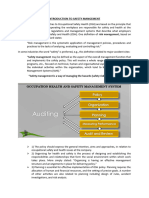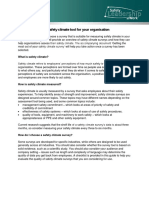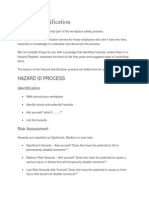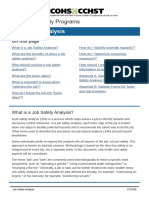Austin 2006
Austin 2006
Uploaded by
MariaCopyright:
Available Formats
Austin 2006
Austin 2006
Uploaded by
MariaOriginal Description:
Copyright
Available Formats
Share this document
Did you find this document useful?
Is this content inappropriate?
Copyright:
Available Formats
Austin 2006
Austin 2006
Uploaded by
MariaCopyright:
Available Formats
An Introduction to
BehaviorBased Safety
by John Austin, PhD
Western Michigan University
rganizations in the aggregates
industry have long recognized
that worker safety is an essential component of the business and that
they can continuously improve their
safety record by reducing injuries. As an
example of the industry-wide commitment to injury reduction, an alliance was
formed between NSSGA and MSHA
wherein a team was assigned to analyze
injuries in the aggregates industry
between 2000-2002 (MSHA/NSSGA,
2003). The team reported that of the
12,147 injuries reviewed, the top injury
classifications were maintenance, repair,
and construction; handling materials;
and slips, trips and falls. The goals of the
report were to identify areas of potential
improvement, to make recommendations for improvement, and to stress the
importance of eliminating all injuries. To
me, this strongly suggests an industry
that has its priorities straight. As you
will read below, an important step in any
injury reduction effort is to conduct a
careful analysis of the current sources of
injuries, to identify areas for potential
improvement.
It is clear that there are many strategies for managing work safety. In this
articlepages, I will discuss just one of
the many effective strategies: behavior-based safety.
38
Whaty Is BehaviorBased Safety?
Its effective. Sulzer-Azaroff and
Austin (2000) found that 31 of 32 published studies describing behavioral
programs in nine industries and seven
countries showed mean decreases in
injury rates of 54 percent. Grindle,
Dickinson, and Boettcher (2000)
reviewed 18 published studies using
behavioral programs in manufacturing
and found that improvements in
behavior over baseline ranged from 9
to 157percent. Although the studies in
these reviews focused on different
behaviors, different industries, and
each used tailored programs for the
worksites where they were implemented, there were some consistent and
fundamental components of each program, and this approach has been
widely described (see Geller, 2001;
McSween, 2004).
The Components of
Behavior-Based Safety
Behavioral safety has four general
components:
1. Identification of change targets
through a careful analysis and
assessment of the data. These targets can and should be anything that
is observable, and research in the
field shows that it is effective to target behaviors, results of behavior,
conditions and situations that are
related to injury. The most common
mistakes in this phase include failing to get employee input about barriers to safety and risky situations to
target, basing targets purely on
opinion rather than data, and targeting only behaviors. The last is the
most potentially devastating to successful safety performances because
injuries always involve behavior,
but they most often also involve
systems, tools and equipment. Failing to measure these other factors
(in addition to behavior) is a sure
condition for program failure.
2. Development of a measurement
system. The most successful behavioral safety processes involve all
employees and management in data
collection. In fact, I once visited a
site that required all visitors to conduct a safety observation, just to see
if visitors catch anything that was
being missed by internal personnel.
Some keys to success in this phase
include getting buy-in from all parties involved to develop an acceptable data collection process; making
the process open to allnot only
front-line workers; collection of
anonymous and accurate data to use
in problem solvingnot fault-finding; and collection of (and later, correction of) barriers to safe behavior.
3. Development of a feedback, reinforcement and problem solving
process. Normally, a good measurement system will include verbal
and graphic feedback (posted by
group data, not individual), positive
reinforcement for safe behavior or
situations, positive reinforcement
for conducting observations, and
problem solving for at-risk behavior or situations. Feedback and
reinforcement should be a two-way
discussion whereby the observer
tells the observed worker what was
recorded on the measurement
checklist and reinforces the safe
Stone, Sand & Gravel Review, January/February 2006
behavior, and feedback should
occur immediately after observation measures are taken.
Problem-solving involves finding
and fixing barriers to safe performance. These most often are identified
during an observation when at-risk
behavior is observed. In these cases,
the observer and performer are
instructed to discuss, is the at-risk
behavior under the control of the performer? If the behavior is not completely under the control of the
performer, then there is a barrier that
must be addressed in order to facilitate
the safe behavior of the performer. If
you have a behavioral process and you
do not engage in this step, you are at
risk of blaming the worker for every
at-risk behavior, which is both demoralizing and unfair to employees. No
one would doubt the assertion that
safety (and injury) results from a combination of environmental and behavioral factors. It is up to observers to
ably discuss this with workers who are
observed so that solutions to at-risk
behavior (and the situations causing
the behavior) can be effectively crafted
and implemented.
4. Continuous improvement of the
process. Behavior-based safety
processes require a great deal of
time, effort, and expertise but as
discussed above, the payoffs can be
considerable. One place where
processes often fail is after implementationthe point at which people start to lose interest unless the
process changes and adapts over
time. There is one way I know of to
make this continuous improvement
happen consistentlyunfortunately, there is little or nothing published on this topic. One thing we
do know though, is that if the components of the process (observation,
feedback, reinforcement, and problem solving) stop happening, then
the effects go away (see for example, Komaki, Barwick, & Scott,
1978).
The way I have helped organizations
deal with the problem of continuous
improvement is through information
sharing meetings called impact groups.
Developed by a colleague named Doug
LaFleur and me, the concept is systematically to share information about safety processes (behavioral or otherwise)
across (or within) sites. At one organization, impact groups started meeting
in 1998, every six months, and are still
meeting today. The concept has now
spread across virtually the entire organization, and the sites with the most lasting processes are avid supporters of the
impact groups process.
The concept works as follows:
every six months, representatives from
several sites (perhaps two reps from
each of four to six sites or areas) convene for two days at a host site, the
location of which rotates among the
group members sites. During the first
morning of the impact group meeting,
each site presents data on the five to
seven critical dashboard measures they
have developed to represent their safety process. The remainder of the day
and the following day are spent analyzing the host sites process through
various programmed techniques such
as interviewing employees and management, observing work behavior and
observing behavioral observations taking place.
The result of the meeting is a list of
action items on which the host can
improve, along with a timeline and
action plan for improvement. The host
then reports back to the group on these
items once or twice before the next
meeting, and at the start of the next
meeting at a new host site. This may
seem extreme, but experience proves
that continuous improvement does not
happen on its ownit takes a great
deal of effort and systematic planning.
This articlepaper is meant to give a
brief overview of the behavior-based
safety process. Many details have been
omitted due to space considerations. I
strongly suggest that you read some of
the research on the topic (see the website below for a reading list), and that
you read as many anti-BBS papers as
you can, such as the position papers
written by the UAW and the Steelworkers, so that you can avoid the
potential pitfalls of BBS. Search the
Internetthere are tons of resources
supporting and opposing BBS, but be
careful to always ask (and look) for
Stone, Sand & Gravel Review, January/February 2006
data on effectiveness (or ineffectiveness) when you encounter potential
solutions. Logical arguments are great,
but they only go so far, and then you
need some data. If you would like to
learn more about this scientific
approach to organizational management, go to www.obmnetwork.com (a
free site of the non-profit group with
which I am involved) and track down
some of the research in behavior-based
safety and Organizational Behavior
Management.
Dr. John Austin is Associate Professor of Psychology in the Applied
Behavior Analysis and IndustrialOrganizational Psychology programs
at Western Michigan University, where
he teaches behavior-based safety, performance management, and organizational consultation; and engages in
consultation for business and industry.
He can be contacted at John.Austin@
wmich.edu
References
Bureau of Labor Statistics (2004). News
release: Workplace injuries and illnesses in
2003. Retrieved at www.bls.gov/iif/oshwc/osh/
os/osnr0021.txt on October 31, 2005.
Geller, E. S. (2001). Working safe: How to
help people actively care for health and safety
(2nd ed.). Lewis Publishers, Inc.
Grindle, A. C., Dickinson, A. M., &
Boettcher, W. (2000). Behavioral safety in manufacturing settings: A review of the literature.
Journal of Organizational Behavior Management, 20(1), 29-68.
Komaki, J., Barwick, K.D., and Scott, L.W.
(1978). A behavioral approach to occupational
safety: Pinpointing and reinforcing safe performance in a food manufacturing plant. Journal
of Applied Psychology, 63(4), 434-445.
McSween, T. (2004). The value-based safety
process: Improving your safety culture with a
behavioral approach. Second edition. John
Wiley & Sons, Inc.: New York, NY.
Mine Safety and Health Administration
(2005). Comparison of year-to-date and total
fatalities for N/NM & coal. Retrieved at
www.msha.gov/stats/charts/chartshome.htm on
November 1, 2005,
Sulzer-Azaroff, B., & Austin, J. (2000).
Does BBS work? Behavior-based safety &
injury reduction: A survey of the evidence. Professional Safety, 45, 19-24.
39
You might also like
- Assignment BBPP1103 Principles of ManagementDocument8 pagesAssignment BBPP1103 Principles of ManagementNajib Roslan67% (3)
- Worksheet Torque Revised 2013 W KeyDocument2 pagesWorksheet Torque Revised 2013 W KeyRyan TomeldenNo ratings yet
- Architecture of SafetyDocument7 pagesArchitecture of SafetyArmando PalmaNo ratings yet
- Improving Safety Culture and Performance: E Scott Geller Public Forums Book Now!Document6 pagesImproving Safety Culture and Performance: E Scott Geller Public Forums Book Now!u_medinaNo ratings yet
- Presentation & Training - HSE Behavior Based SafetyDocument26 pagesPresentation & Training - HSE Behavior Based SafetyHimawan Sutardjo100% (7)
- Behaviour Based SafetyDocument3 pagesBehaviour Based SafetyCostis50% (2)
- Rule-Governed Behavior and Psychological ProblemsDocument16 pagesRule-Governed Behavior and Psychological ProblemsMariaNo ratings yet
- Stokes and Baer 1977Document19 pagesStokes and Baer 1977Maria100% (1)
- Early Behavioral InterventionDocument29 pagesEarly Behavioral InterventionMariaNo ratings yet
- Behavior Based Safety in The WorkplaceDocument31 pagesBehavior Based Safety in The WorkplaceSakinah Mhd ShukreeNo ratings yet
- Focus Intervention On Observable BehaviorDocument5 pagesFocus Intervention On Observable BehaviorHujjatul IslamNo ratings yet
- Memorandum 04 - WeeblyDocument4 pagesMemorandum 04 - Weeblyapi-231740690No ratings yet
- BBS PDFDocument3 pagesBBS PDFValentinNo ratings yet
- Behaviour Based SafetyDocument26 pagesBehaviour Based SafetyTarun Kakkar0% (1)
- M.E-ISE-2022-24-SM-Introduction To Safety Management-Folder No.1Document7 pagesM.E-ISE-2022-24-SM-Introduction To Safety Management-Folder No.1Veeramuthu SundararajuNo ratings yet
- Procedures For Identifying and Correcting Safety ProblemsDocument3 pagesProcedures For Identifying and Correcting Safety ProblemsZulSal SalNo ratings yet
- Behavioral Based SafetyDocument14 pagesBehavioral Based SafetyZekie LeeNo ratings yet
- Root Cause Analysis ToolsDocument31 pagesRoot Cause Analysis ToolsDanielaGarcia100% (3)
- MME30001 Minor Activity OHS With Suggested Answers PDFDocument5 pagesMME30001 Minor Activity OHS With Suggested Answers PDFMosesNo ratings yet
- Behaviouralsafetyf PDFDocument14 pagesBehaviouralsafetyf PDFAntony JebarajNo ratings yet
- Vietnam War Change Linear Analogy Dominoes: American Psychological Association (APA)Document8 pagesVietnam War Change Linear Analogy Dominoes: American Psychological Association (APA)FERNANDO YZAGUIRRENo ratings yet
- Risk Management Task 4Document8 pagesRisk Management Task 4Naushal SachaniyaNo ratings yet
- A System of SafetyDocument14 pagesA System of SafetykerpushpaNo ratings yet
- Lessons Learned 04 21Document17 pagesLessons Learned 04 21vasu_suvaNo ratings yet
- Behavior Based Safety Approach To Advance Injury Free CultureDocument7 pagesBehavior Based Safety Approach To Advance Injury Free CultureRibka FridayNo ratings yet
- 6 Mistakes in Implementing BBSDocument4 pages6 Mistakes in Implementing BBSAdvaitNo ratings yet
- Root Cause AnalysisDocument2 pagesRoot Cause Analysis360 International LimitedNo ratings yet
- Risk Management Term Paper TopicsDocument8 pagesRisk Management Term Paper Topicsafmzswxbbbbitf100% (1)
- BBS and SMS 27-30 Sot 2014Document48 pagesBBS and SMS 27-30 Sot 2014Ranjith KrishnanNo ratings yet
- BBS 1-1-dDocument13 pagesBBS 1-1-dabd el fattah mohamedNo ratings yet
- Occupational Safety and Health - Edited - 031250Document10 pagesOccupational Safety and Health - Edited - 031250abednego kipronoNo ratings yet
- Does BBS WorkDocument6 pagesDoes BBS Worknvelja_760907988No ratings yet
- Behaviour Based Safety in United Kingdom UKDocument6 pagesBehaviour Based Safety in United Kingdom UKshuperduperman1No ratings yet
- Safety 7 PDFDocument12 pagesSafety 7 PDFAjejejeNo ratings yet
- Looking For Higher StandardsDocument16 pagesLooking For Higher StandardsKhalid Mahmood AwanNo ratings yet
- When Workplace Safety Depends On Behavior Change Topics For Behavioral Safety ResearchDocument10 pagesWhen Workplace Safety Depends On Behavior Change Topics For Behavioral Safety ResearchNuzuliana EnuzNo ratings yet
- Language Selection: Search Site MenuDocument13 pagesLanguage Selection: Search Site MenujaydeeNo ratings yet
- P171811Document14 pagesP171811Emiel RoestenburgNo ratings yet
- HRM Health and Safety On WorkplaceDocument23 pagesHRM Health and Safety On WorkplaceSevil Yusupova100% (1)
- Addressing Ergonomic Hazards Through Behavioral Observation and FeedbackDocument6 pagesAddressing Ergonomic Hazards Through Behavioral Observation and FeedbacktheleoneNo ratings yet
- Behavioral Based Safety FinalDocument18 pagesBehavioral Based Safety FinalIamKim Cera100% (1)
- Safety ManagementDocument4 pagesSafety ManagementNasir AnsariNo ratings yet
- Benefits of Doing A Job Safety AnalysisDocument10 pagesBenefits of Doing A Job Safety AnalysisCartila MawratiNo ratings yet
- Security Risk Management: COSC 454Document7 pagesSecurity Risk Management: COSC 454Silver LisingNo ratings yet
- Behaviour Based Safety: The ABC's of BBSDocument8 pagesBehaviour Based Safety: The ABC's of BBSWiZofFaTeNo ratings yet
- Violence Risk Assessment Tool May 2017Document11 pagesViolence Risk Assessment Tool May 2017Hassani Roohani Ahlesunnat Dadu Branch MoroNo ratings yet
- Choosing The Right Safety Climate ToolDocument5 pagesChoosing The Right Safety Climate ToolfitrianiNo ratings yet
- Hazard IdentificationDocument11 pagesHazard Identificationcedro08No ratings yet
- Accident InvestigationDocument5 pagesAccident InvestigationMaheshNo ratings yet
- JSA CanadaDocument12 pagesJSA Canadaandika nstNo ratings yet
- Basic Elements of A Comprehensive Root Cause Analysis ProgramDocument4 pagesBasic Elements of A Comprehensive Root Cause Analysis ProgramLLNo ratings yet
- Safety and RiskDocument16 pagesSafety and RiskVidula KNo ratings yet
- 501 Manage Risk Task 4 Knowledge QuestionsDocument10 pages501 Manage Risk Task 4 Knowledge Questionskaurhusanpreet1996No ratings yet
- 10 QuestionsDocument4 pages10 QuestionsyasinNo ratings yet
- Safety Manual Behavior Based Safety ProgramDocument10 pagesSafety Manual Behavior Based Safety ProgramVictor TasieNo ratings yet
- F2Blair 0810Document6 pagesF2Blair 0810fitrianiNo ratings yet
- A System of Safety Management Practices PDFDocument14 pagesA System of Safety Management Practices PDFAnonymous FmXEu2cHxK100% (1)
- Unit 1 AssessmentDocument18 pagesUnit 1 AssessmentCharlie PopovicNo ratings yet
- Job Safety Analysis by GautamDocument7 pagesJob Safety Analysis by Gautamgauti0102No ratings yet
- Topic 2. Quiz 2Document4 pagesTopic 2. Quiz 2Emilio Joaquin FloresNo ratings yet
- Incident InvestDocument8 pagesIncident InvestAndy DolmanNo ratings yet
- Occupational HealthDocument10 pagesOccupational HealthFejza100% (1)
- Main Campus, Sogod, Southern LeyteDocument11 pagesMain Campus, Sogod, Southern LeyteEep JayNo ratings yet
- Risk Management Using Failure Mode and Effect Analysis (FMEA)From EverandRisk Management Using Failure Mode and Effect Analysis (FMEA)No ratings yet
- Apperception TestDocument91 pagesApperception TestMaria100% (2)
- Functional CommunicationDocument10 pagesFunctional CommunicationMariaNo ratings yet
- Experimental Analysis and Extinction of Self Injury BehaviorDocument17 pagesExperimental Analysis and Extinction of Self Injury BehaviorMariaNo ratings yet
- Functional Analysis and Treatment of Inappropriate Verbal BehaviorDocument3 pagesFunctional Analysis and Treatment of Inappropriate Verbal BehaviorMariaNo ratings yet
- Behavioral Treatment and Normal Educational and Intellectual Functioning in /bung Autistic ChildrenDocument7 pagesBehavioral Treatment and Normal Educational and Intellectual Functioning in /bung Autistic ChildrenMariaNo ratings yet
- Good Bye, Teacher Fred S. KellerDocument11 pagesGood Bye, Teacher Fred S. KellerAlberto ZapataNo ratings yet
- Tantrums Associated With Transitions in Preschool KidsDocument5 pagesTantrums Associated With Transitions in Preschool KidsMariaNo ratings yet
- Verbal BehaviorDocument14 pagesVerbal BehaviorMariaNo ratings yet
- ESCAPE BEHAVIOR McComas Et Al. 2000Document15 pagesESCAPE BEHAVIOR McComas Et Al. 2000MariaNo ratings yet
- Implications and Refinements of The Establishing Operation ConceptDocument10 pagesImplications and Refinements of The Establishing Operation ConceptMariaNo ratings yet
- How To Draw CatsDocument32 pagesHow To Draw Catskimdenson100% (1)
- Design of Columns: I.Determination If Long Column or Short ColumnDocument26 pagesDesign of Columns: I.Determination If Long Column or Short ColumnJohn Paul Hilary EspejoNo ratings yet
- Laboratory Solutions: Sample Preparation For The Most Stringent Analytical RequirementsDocument37 pagesLaboratory Solutions: Sample Preparation For The Most Stringent Analytical Requirementsomar rahmounNo ratings yet
- Lecture 11 Motion in A Plane Introduction To Polar CoordinatesDocument11 pagesLecture 11 Motion in A Plane Introduction To Polar CoordinatesAnonymous yorzHjDBdNo ratings yet
- National Foreign Languages Project 2020 (E 2020 PROJECT)Document14 pagesNational Foreign Languages Project 2020 (E 2020 PROJECT)Dũng NguyễnNo ratings yet
- TechnicalReport Tasiast May08Document119 pagesTechnicalReport Tasiast May08douglasnespoliNo ratings yet
- ConnectB2 TRM RevTest3-FCEDocument2 pagesConnectB2 TRM RevTest3-FCEelceffie100% (2)
- Axial-Fan Transformers enDocument36 pagesAxial-Fan Transformers enEko SusantoNo ratings yet
- CE 205 Fluid Mechanics Lecture 1 CE 205Document27 pagesCE 205 Fluid Mechanics Lecture 1 CE 205Mubarak PatelNo ratings yet
- Semi Fully Automatic BrochureDocument24 pagesSemi Fully Automatic BrochureshivpintuNo ratings yet
- Furnace - FBF075B12A5 ManualDocument16 pagesFurnace - FBF075B12A5 Manualcab13guyNo ratings yet
- Requirement of Experienced Non-Executive PersonnelDocument8 pagesRequirement of Experienced Non-Executive PersonnelHarpreet Singh KapoorNo ratings yet
- Codigo Fallas CDocument3 pagesCodigo Fallas CarielNo ratings yet
- Assignment 30%Document3 pagesAssignment 30%Misge ChekoleNo ratings yet
- Defects in Plaster & RemediesDocument3 pagesDefects in Plaster & RemediesGaurav DhumneNo ratings yet
- WE43 CaDocument13 pagesWE43 Cabulucgheorghe25No ratings yet
- Multiple Choice QuestionsDocument18 pagesMultiple Choice QuestionsDeepika DeepikaNo ratings yet
- AFIO 2012 HR Quarterly ReportDocument12 pagesAFIO 2012 HR Quarterly ReportMark BuendiaNo ratings yet
- X10 Lola Mk11aDocument19 pagesX10 Lola Mk11aJorge Daniel GualterosNo ratings yet
- XT Systems Brochure - WebDocument4 pagesXT Systems Brochure - WebYoissNo ratings yet
- Chapter 5 - Methods of PaymentDocument71 pagesChapter 5 - Methods of PaymentThảo Nhi Nguyễn VõNo ratings yet
- DataCom EngineerDocument2 pagesDataCom EngineerAdeelNo ratings yet
- 4.facilitate Learning Sessions 1Document199 pages4.facilitate Learning Sessions 1ahmie banezNo ratings yet
- Final Camping ProgramDocument2 pagesFinal Camping ProgramJomar FamaNo ratings yet
- A Pocket Guide To The EU's New Fish and Aquaculture Consumer Labels PDFDocument20 pagesA Pocket Guide To The EU's New Fish and Aquaculture Consumer Labels PDFPrabhakara Rao ThanikondaNo ratings yet
- NSQHS Standards Fact Sheet Standard 1Document2 pagesNSQHS Standards Fact Sheet Standard 1Annette LowryNo ratings yet
- CHAMP XD3 Data SheetDocument7 pagesCHAMP XD3 Data Sheetdadabarghi66No ratings yet
- Restaurant Industry - UAEDocument4 pagesRestaurant Industry - UAEAdey Salamin100% (1)
- Stubs and DriversDocument4 pagesStubs and DriversAreej Al MajedNo ratings yet







































































































